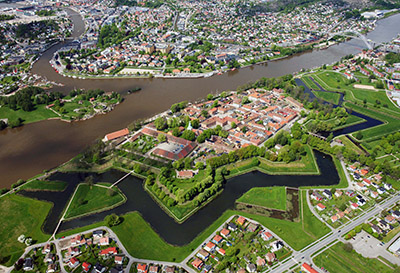 |
Fredrikstad Fortress
Fredrikstad, Norway
|
|
 |
Constructed: 1663-1666
Used by: Norway, Sweden
Conflict in which it participated:
Swedish-Norwegian War (1814)
|
Scandinavia owes a huge debt to Sweden for being such an energetic bully in the 17th century. How else would Norway, Finland and Denmark have solidified their national identities, if not for the necessity of defending themselves from obnoxious Sweden?
The story of Fredrikstad begins with the city of Sarpsborg, Norway. Founded (heroically by Vikings) in 1016, this city was burnt to the ground in 1567 by the Swedish forces of King Eric XIV (1533-1577).
|
 |
|
|
This was during the Northern Seven Years' War (1563-1570), which was fought by the kingdoms of Scandinavia (Sweden vs. Norway, Denmark, the Free City of Lübeck and the Polish-Lithuanian Union) over, well, a variety of things, but mostly because Sweden felt like it.
The surviving residents of Sarpsborg, who suddenly found themselves townless, asked King Frederick II (1534-1588) if they could pretty please rebuild their town at a better location: At a more easily defensible and commercially viable spot about nine miles south of the burnt Sarpsborg.
|
One of Fredrikstad's covered gates, an interesting take on a casemate. Would this have been as strong as the standard, rounded-top casemate? Let's ask the Swedes to sling some shells at it and find out! |
 |
The romantically-named Glomma River was one of the routes a Swede might take when heading for Oslo with a burning torch in hand, and Sarpsborg had been at least a bump in the road on the way to Oslo, so the King agreed. The town was rebuilt where the Glomma and Vesterelva Rivers meet, and was officially christened Fredrikstad in 1569.
Fredrikstad's first temporary fortification was built during the Hannibal War (1643-1645), fought betwixt Denmark/Norway and Sweden over a variety of leftover issues from their previous war. This fortification, an earthwork, was made permanent starting in 1660. |
|
Norway was forced to cede a couple of important forts to Sweden during the was, one being Bohus Fortress, which made Fredrikstad even more important in a strategic sense. Johan Caspar von Cicignon (1625-1696), an engineer in the employ of Denmark/Norway, was responsible for Fredrikstad's starfort upgrade. |
Fredrikstad Fortress served Norway well, as the stronghold and magazine of both the southern regiments of the army and the kingdom's naval fleet. At the height of preparedness, the fort bristled with 200 guns and was manned by up to 2,000 soldiers.
In the years leading up to the Napoleonic Wars (1803-1815), Great Britain's Royal Navy worked to prevent other nations from trading with revolutionary France, as any nation without a proper king has got to be trouble. Denmark-Norway joined the League of Armed Neutrality with Russia, Sweden and Prussia, insisting on their right to trade with whomever they wished.
|
 |
Ah, to fight in the days when a cannon's wheels looked like a rickety wooden Viking shield. |
|
The Royal Navy defeated a Danish-Norwegian fleet at Copenhagen in 1801. Denmark-Norway allied themselves with France once the Napoleonic Wars (1803-1814) got properly rolling, which of course put them on the losing side, and in a somewhat depleted state, when Napoleon (1769-1821) was finally defeated in 1814.
The Treaty of Kiel (1814) officially concluded hostilities between Britain and Sweden on one side, and Denmark-Norway on the other. As part of this treaty, Denmark was forced to cede Norway to Sweden. Norway took this opportunity to declare independence, and the Swedish-Norwegian War (1814) was on, as Sweden did what it could to squash this silly concept of independence.
In one of the final acts of this brief war, Sweden's navy sailed against Fredrikstad Fortress in August of 1814. After two days of bombardment, the fortress surrendered to the Swedes. Though Norway did indeed become part of a "Personal Union with Sweden" after the negotiations that ended this war, it did so with its own Parliament and Constitution in place, and thus at least with nominal independence.
|
 The Glomma and Vesterelva Rivers meet at Fredrikstad. The Glomma and Vesterelva Rivers meet at Fredrikstad. |
 |
Fredrikstad Fortress was decommissioned in 1903, and Norway peacefully separated from Sweden on June 7, 1905, marking the first time it had been fully independent in 586 years. The fortress' garrison, the Østfold Regiment, remained in place until 2002.
From 1990 to 1994, Fredrikstad Fortress underwent an extensive restoration process, which brought it to the vision of loveliness that we see today.
Many thanks to starfort enthusiast Don Bryant, who found Fredrikstad Fortress for us...and to Therese Christie Flodin, who gently informed me as to how to spell the word, Vesterelva. |
|
|
|
|
|
|
 |




